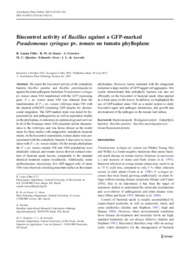Biocontrol activity of Bacillus against a GFP-marked Pseudomonas syringae pv. tomato on tomato phylloplane.
Biocontrol activity of Bacillus against a GFP-marked Pseudomonas syringae pv. tomato on tomato phylloplane.
Autoria: LANNA FILHO, R.; SOUZA, R. M.; FERREIRA, A.; QUECINE, M. C.; ALVES, E.; AZEVEDO, J. L. de
Resumo: We report the biocontrol activity of the endophytic bacteria Bacillus pumilus and Bacillus amyloliquefacies against the plant pathogenic bacteriumPseudomonas syringae pv.tomato strain NS4 transformed with theGFPexpressing gene. P. s . pv. tomato strain NS4 was obtained from the transformation of P. s .pv.tomato wild-type strain NW with the plasmid pNKGFP containing GFP-cassette for chromosomal integration. The GFP-marked strain was tested for hypersensitivity and pathogenicity, as well as population studies on the phylloplane, to determine its epidemiology and survival. In all of the bioassays strain NS4 presented similar characteristics to the wild-type, and was hence chosen as the model strain for these studies with antagonistic endophytic bacterial strains. In the biocontrol experiments, tomato plants were preinoculated with the endophytic bacteria 4 days prior to inoculation withP. s .pv.tomatostrains. On the tomato phylloplane the P. s .pv.tomato (strains NW and NS4) populations were drastically reduced, and tomato leaves showed reduced numbers of bacterial speck lesions, comparable to the standard chemical treatment copper oxychloride. Additionally, under epifluorescence microscopy, few GFP-tagged cells of strain NS4 were observed colonizing important niches on the tomato phylloplane. However, leaves untreated with the antagonists presented a large number of GFP-tagged cell aggregates. Our results demonstrated that endophytic bacteria can also act efficiently on the biocontrol of bacterial speck when applied as a foliar spray on the leaves. In addition, we highlighted the use of GFP-marked strain NS4 as a model system to study biocontrol agent and pathogen interactions, and growth and development of the pathogen on the tomato leaf surface.
Ano de publicação: 2013
Tipo de publicação: Artigo de periódico
Unidade: Embrapa Agrossilvipastoril
Observações
1 - Por padrão são exibidas publicações dos últimos 20 anos. Para encontrar publicações mais antigas, configure o filtro ano de publicação, colocando o ano a partir do qual você deseja encontrar publicações. O filtro está na coluna da esquerda na busca acima.
2 - Para ler algumas publicações da Embrapa (apenas as que estão em formato ePub), é necessário ter, no celular ou computador, um desses softwares gratuitos. Sistemas Android: Google Play Livros; IOS: iBooks; Windows e Linux: software Calibre.
Acesse outras publicações
Acesse a Base de Dados da Pesquisa Agropecuária (BDPA) para consultar o acervo completo das bibliotecas da Embrapa.

